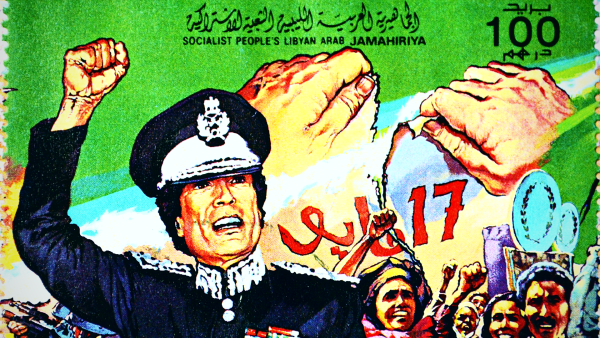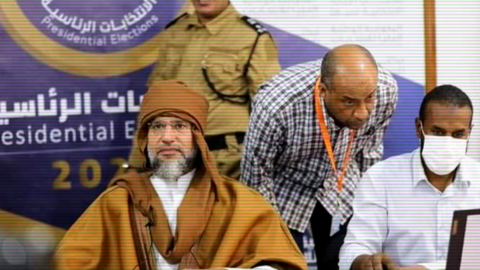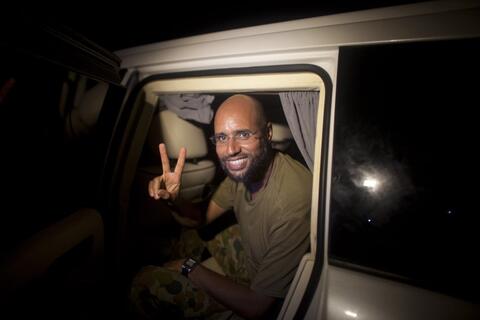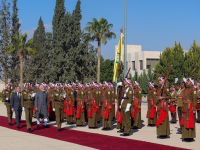From time to time, we see internet articles, social media posts, and most recently TikTok videos comparing Libya's economic situation before and after the reign of former leader Muammar Gaddafi, who ruled the country for nearly 42 years, before being ousted by the Arab Spring revolution that received NATO support in 2011.
One of the most recent internet videos breaking down what is believed to be the "perks" of Muammar Gaddafi's rule, is a viral TikTok by Count Daedalus, during which the user shared 'facts' about Libya under Muammar Gaddafi.
Count Daedalus rightfully attributes most of the wealth distributed by Muammar Gaddafi among Libyans to the oil wealth Libya has enjoyed since the early 1970s, which continues to be one of the most valuable resources of wealth in the country, even after 11 years of the post-Gaddafi era.
Currently, Libya does live through some of its most challenging times, due to political unrest that continues to rock the country even after years of civil war that only ended in 2020.
@countdaedalus Replying to @boomtagsware #fyp #countdaedalus #libya #gaddafi #history #nato #clinton #usa #uk #politics #libya?? ♬ original sound - Count Daedalus
In this article, we will break down the different "facts" showcased by Count Daedalus, who continued to post another video deeming Muammar Gaddafi as a "dictator", to make sure his followers do not assume his previous video was pro-Gaddafi.
Count Daedalus, who jokingly called Muammar Gaddafi "the most stylish dictator" may have gotten a few things right, but we took the "facts" he mentioned and inquired further about them from a number of Libyans who lived under his rule.
Despite his uncanny style and beliefs, Muammar Gaddafi was able to remain in power between 1969 and 2011.
During those 42 years, Muammar Gaddafi made drastic changes to the lives of different generations of Libyans, such as building a largely socialist economy and advocating for Arab and African nationalism, that he even always liked to be called "the King of Kings of Africa", citing his plans to create a gold-backed African currency that was going to be "freed from the International Monetary Fund" and "potentially compete with US dollar". However, these plans never came true.
He had made it to power after a military coup against the King Idris of Libya, who was then sent to exile in Egypt.
Libya Under Muammar Gaddafi... How true?
Source: Twitter
1- By the end of Muammar Gaddafi's reign, Libya was ranked first on the human development index in Africa.
This might be true on paper. In 2010, the Human Development Index published by United Nations Development Programme ranked Libya as the top African country in terms of education levels, medical services, and life expectancy.
Yet, Count Daedalus fails to mention that Libya, a country that owns major reserves of both oil and gas and has an extremely small population compared to its area, ranked 52nd globally, unlike many other countries with similar natural resources.
Finally, such reports often rely on figures provided by government officials, which can not always be trusted in countries where leaders would do everything possible to prove their decades-long in power were "worth it".
2- No electricity bills at all.
According to many Libyans who lived during Muammar Gaddafi's rule, this is true. Electricity was largely granted to everyone in the oil-rich country for little to no charge at all.
3- Interest-free bank loans
This is another true fact mentioned by Count Daedalus in the video. State-owned Libyan banks were offering loans with 0 interest, particularly to Libyan youth so they could buy houses, cars, or get married.
4- Housing was a human 'right'
As would any socialist regime, Muammar Gaddafi's Libya granted every Libyan adult to own a house. This seems to be true and it has been confirmed by three different individuals.
However, one point missed by Count Daedalus and other online people is that to apply this rule, Muammar Gaddafi forcefully granted tenants the houses they were renting at that time, depriving original owners of properties they had developed, saved money, and built or purchased.
One of the Libyans we interviewed, who prefers to stay anonymous, talked to Albawaba about "The Right to Occupancy" issued by Gaddafi's regime, which states that a "house belongs to its resident".
The person explained that this rule had caused major financial losses to their family as they lost houses they were renting, while they were forced to spend decades in the small house they resided in at the time the law was passed.
5- Muammar Gaddafi lived in a tent
It is true that the former Libyan leader had his own tent for decades, at which he hosted international guests including officials and heads of state, and moved to other countries during his travels. But the tent was not everything Muammar Gaddafi owned.
Shortly after his regime was overthrown in 2011, hundreds of Libyans were finally able to break into a number of his "royal palaces" only to discover extravagant buildings with every possible luxurious item in existence, including several golden statues.
After the toppling of Muammar Gaddafi in the fall of 2011, his wealth was estimated to be around $200 billion USD to his name, not to mention that many other billions were owned by his wife and eight biological children, many of whom had led just as lavish lifestyles.
6- Education and health services were completely FREE
This claim was also confirmed by every Libyan we talked to while writing this article.
One of the Libyans we contacted, who prefers to stay anonymous, confirmed this as a fact but highlighted that both sectors were severely underdeveloped during Muammar Gaddafi's reign, which he thinks was "one of the main triggers of the Arab Spring revolution in Libya in 2011".
7- Encouraging farming
According to two of the sources we contacted, Libyan governments under Gaddafi had long encouraged farming practices across the country, offering massive areas of land as well as needed equipment, seeds, and live stocks for free for aspiring farmers.
Gaddafi was also credited for the Great Man-Made River, which consisted of the world's largest irrigation system built between 1984 and 2002, meant to provide fresh water for all Libyan cities.
The project is believed to have cost around $30 billion and was established in cooperation with companies from Korea, Japan, Germany, Turkey, Philipeneses, and the United Kingdom.
Despite the lack of official reports on the outcome of the project, many Libyan experts point to major cases of corruption that accompanied the project over the years. Corruption is estimated to have cost the project an additional $10 billion.
They also note that the Great Man-Made River posed a critical environmental and social challenge, particularly in the south of Libya, where groundwater wells were destroyed, killing different species and eventually resulting in displacing remote communities that lived in the south of Libya.
8- Muammar Gaddafi did not 'kill' many people
In his video, Count Daedalus claimed that Muammar Gaddafi did not 'kill" many people in Libya, saying "he was crazy, but not to the point where he became a danger to the population" and that "he did not exactly send hundreds of thousands of his own people to chambers".
While the world still debates the exact number of people who were killed during the first few months of the Libyan revolution against Colonel Muammar Gaddafi in 2011, the minimum figure is estimated to be 2,500 individuals, while the maximum is around 25,000. Both numbers constitute a major loss of human life, especially knowing that Libya's population in 2011 was only near 6.2 million people.
If we were to look prior to the 2011 revolution, Muammar Gaddafi was greatly feared by his people for a number of terrifying incidents in which he killed political opponents and critics over the years. The most famous of all is the execution of Libyan dissident Al-Sadek Hamed Al-Shuwehdy on the 7th of April, 1984, following a failed coup attempt. Muammar Gaddafi's regime had then accused Sadek Hamed Al-Shuwehdy of "being a member of the Muslim Brotherhood and of being an agent working for the United States".
At that time, Muammar Gaddafi had ordered a mass gathering of university students in a football stadium in the city of Benghazi, only to surprise them with the execution taking place in the field upon their eyes, which was since perceived as an attempt to scare any future critics from taking action against him.
Gaddafi’s special team of female bodyguards: A dark story of rape and violence. > https://t.co/Om7RvOgafz #F2FA #africa #panafrican #diaspora pic.twitter.com/htp9gpbSPa
— Face2face Africa (@Face2faceAFRICA) January 23, 2021
Videos of the well-known execution are available online and have been seen by most Libyans ever since.
Following his capture by rebels and death in October 2011, several of his unique all-female cadre of bodyguards came forward saying that Muammar Gaddafi used to abuse and rape them, saying they did not dare to report such offenses when he was in power.









